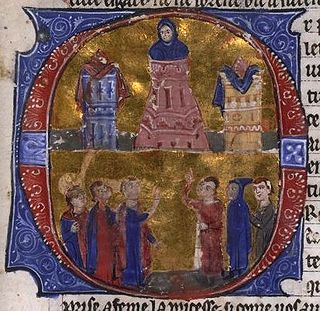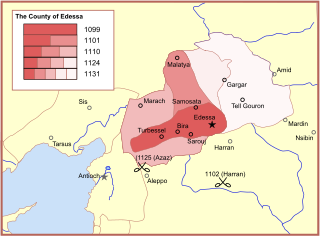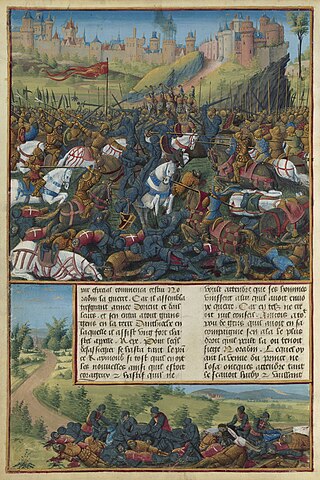Related Research Articles

Baldwin III was the king of Jerusalem from 1143 to 1163. He was the eldest son of Melisende and Fulk of Jerusalem. He became king while still a child, and was at first overshadowed by his mother Melisende, whom he eventually defeated in a civil war. During his reign Jerusalem became more closely allied with the Byzantine Empire, and the Second Crusade tried and failed to conquer Damascus. Baldwin captured the important Egyptian fortress of Ascalon, but also had to deal with the increasing power of Nur ad-Din in Syria. He died childless and was succeeded by his brother Amalric.

Bohemond II was Prince of Taranto from 1111 to 1128 and Prince of Antioch from 1111/1119 to 1130. He was the son of Bohemond I, who in 1108 was forced to submit to the authority of the Byzantine Empire in the Treaty of Devol. Three years later, the infant Bohemond inherited the Principality of Taranto under the guardianship of his mother, Constance of France. The Principality of Antioch was administered by his father's nephew, Tancred, until 1111. Tancred's cousin, Roger of Salerno, managed the principality from 1111 to 1119. After Roger died in the Battle of the Field of Blood, Baldwin II of Jerusalem took over the administration of Antioch. However, he did acknowledge Bohemond's right to personally rule the principality upon reaching the age of majority.

Raynald of Châtillon, also known as Reynald, Reginald, or Renaud, was a knight of French origin who became Prince of Antioch from 1153 to 1160 or 1161 and Lord of Oultrejordain from 1175 until his death. The second son of a French noble family, he joined the Second Crusade in 1147, and settled in the Kingdom of Jerusalem as a mercenary. Six years later, he married Constance, Princess of Antioch, in spite of her subjects' opposition.

Imad al-Din Zengi, also romanized as Zangi, Zengui, Zenki, and Zanki, was a Turkoman atabeg, who ruled Mosul, Aleppo, Hama, and, later, Edessa. He was the namesake of the Zengid dynasty.

Nūr al-Dīn Maḥmūd Zengī, commonly known as Nur ad-Din, was a member of the Zengid dynasty, which ruled the Syrian province of the Seljuk Empire. He reigned from 1146 to 1174. He is regarded as an important figure of the Second Crusade.

Baldwin II, also known as Baldwin of Bourcq or Bourg, was Count of Edessa from 1100 to 1118, and King of Jerusalem from 1118 until his death. He accompanied his cousins Godfrey of Bouillon and Baldwin of Boulogne to the Holy Land during the First Crusade. He succeeded Baldwin of Boulogne as the second count of Edessa when he left the county for Jerusalem following his brother's death. He was captured at the Battle of Harran in 1104. He was held first by Sökmen of Mardin, then by Jikirmish of Mosul, and finally by Jawali Saqawa. During his captivity, Tancred, the Crusader ruler of the Principality of Antioch, and Tancred's cousin, Richard of Salerno, governed Edessa as Baldwin's regents.

The County of Edessa was a 12th-century Crusader state in Upper Mesopotamia. Its seat was the city of Edessa.
Joscelin I was a Frankish nobleman of the House of Courtenay who ruled as the lord of Turbessel, prince of Galilee (1112–1119) and count of Edessa (1118–1131). The County of Edessa reached its zenith during his rule. Captured twice, Joscelin continued to expand his county, even participating in the Battle of Azaz in 1125. Gravely injured during the collapse of a sapper mine, Joscelin marched his army to relieve the besieged fortress of Kaysun, and died soon after.

Joscelin II was the fourth and last ruling count of Edessa. He was son of his predecessor, Joscelin I, and Beatrice, daughter of Constantine I of Armenia.
Joscelin III was the titular count of Edessa, who during his lifetime managed to amass enough land to establish a lordship in the Kingdom of Jerusalem.
Constance of Hauteville (1128–1163) was the ruling princess of Antioch from 1130 to 1163. She was the only child of Bohemond II of Antioch and Alice of Jerusalem. Constance succeeded her father at the age of two after he fell in battle, although his cousin Roger II of Sicily laid claim to Antioch. Alice assumed the regency, but the Antiochene noblemen replaced her with her father, Baldwin II of Jerusalem. After he died in 1131, Alice again tried to take control of the government, but the Antiochene barons acknowledged the right of her brother-in-law Fulk of Anjou to rule as regent for Constance.

The Battle of Inab, also called Battle of Ard al-Hâtim or Fons Muratus, was fought on 29 June 1149, during the Second Crusade. The Zengid army of Atabeg Nur ad-Din Zangi destroyed the combined army of Prince Raymond of Poitiers and the Assassins of Ali ibn-Wafa. The Principality of Antioch was subsequently pillaged and reduced in size as its eastern border was pushed west.
Alice of Jerusalem was a Princess consort of Antioch by marriage to Bohemond II of Antioch. She engaged in a longlasting power struggle during the reign of her daughter Constance of Antioch.

The siege of Edessa took place from November 28 to December 24, 1144, resulting in the fall of the capital of the crusader County of Edessa to Zengi, the atabeg of Mosul and Aleppo. This event was the catalyst for the Second Crusade.
In the Battle of Aintab in August 1150, a Crusader force commanded by King Baldwin III of Jerusalem repelled the attacks of Nur ad-Din Zangi of Aleppo and evacuated the Latin Christian residents of the County of Edessa. This was both a tactical victory and a strategic defeat for the Crusaders.

The timeline of the Principality of Antioch is a chronological list of events of the history of the Principality of Antioch.
William of Zardana, also known as William of Saone, was a powerful baron who held Balatanos, Saone and Zardana in the Principality of Antioch. After his father, Robert the Leper, was executed by the atabeg of Toghtekin in 1119, William inherited Balatanos and Saone. Zardana, that his father had lost before his death, was restored to William by Baldwin II of Jerusalem in 1121. He supported Baldwin II's daughter, Alice, against her brother-in-law, Fulk of Jerusalem, in 1132, but Fulk defeated her allies. William died fighting either against Fulk's troops or against a Muslim army.
Husam al-Din Timurtash was an Artuqid emir of Mardin (1122–1154) and ruler of Aleppo (1124–1125).
The Fall of Turbessel occurred in 1151 when the Turks seized Turbessel as well as other possessions that Joscelin II had just ceded to the Byzantines.
Gündoğan, historically Turbessel, is a neighbourhood in the municipality and district of Oğuzeli, Gaziantep Province, Turkey. Its population is 374 (2022). It was originally a fortress that played an important role in the Crusades, remnant of which is a tumulus.
References
- ↑ Nicholson 1973, p. 1.
- ↑ Barber 2012, p. 232.
- ↑ Buck 2017, pp. 147–148.
- ↑ Nicholson 1973, pp. 1–2.
- ↑ Buck 2017, p. 148.
- 1 2 Barber 2012, p. 152.
- ↑ Barber 2012, pp. 179–180.
- ↑ Barber 2012, p. 180.
- 1 2 3 4 Nicholson 1973, p. 21.
- 1 2 3 4 Barber 2012, p. 195.
- ↑ Nicholson 1973, pp. 22–23.
- 1 2 Nicholson 1973, p. 23.
- ↑ Barber 2012, pp. 231–232.
- 1 2 3 Nicholson 1973, p. 24.
- ↑ Nicholson 1973, pp. 24–25.
- ↑ Hamilton 2000, p. 24.